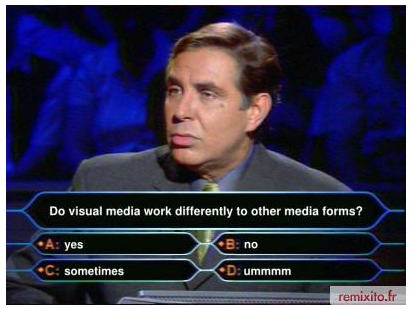It’s a hard question… but I’d say C) sometimes.
For the most part, visual media act in much the same way as other media forms, they are just a varied combination of expression and content.
In the same way that other media forms modulate publics and their experience, so to do visual media. However, the visual has a greater ability to do this in ‘real time’. Looking at the climate change advocacy blog CO2Now.org, this principle is demonstrated quietly clearly (their tag line is “watch CO2 now and know the score of global warming practically in real time”). The name says it all – CO2 now.
The images they present magnify the data collected about the atmospheric levels of CO2 from year to year. The increases are marginal when the data set is placed before you. However, turn these into stark numbers on a dark background ascending in both size and position and the audience’s cognitive response is likely to be altered. Any average person who, out of curiosity, run a Google search of “CO2 now” hoping to find some basic information or a single figure, are immediately directed to this blog.
Therefore, latent publics are more likely to be mobilised around the previously exclusive debate, by the heightened capacity of visual representations.
Symbols, widely used in visual media, are motivated signs – the thing to which they refer largely dictates their meaning. Yet, the nature of symbols is changing. Traditionally motivated signs have the ability to be more freely manipulated as the landscape of visual media expands, allowing them to more readily act in much the same way as the verbal form.
The main point of difference here for the visual is the role that context can play. The polar bear image that accompanies “Struggling polar bears put on endangered list” (Metro.co.uk 2008) is a perfect example of this. The isolated instance conveyed in the image surpasses its ability to signify an actual polar bear. When played adjacent to the confronting headline and the article that ensues, the polar bear by way of association, comes to signify ideas, emotions and the argument for climate change. The context where the visual is published also matters. The polar bear image was published on a news site – one with an audience not exclusive to those engaged in the climate change debate. This demonstrates further that the emotive capacity of the polar bear as a symbol is furthered by the fact that it’s audience are less aware of the scientific debate it comes to represent.
Anon. (2008) ‘Struggling polar bears put on endangered list’, Metro.co.uk, May 15, accessed April 28 2012 <http://www.metro.co.uk/news/147937-struggling-polar-bears-put-on-endangered-list>
CO2 Now.org 2011, accessed April 28 2012 <http://co2now.org>


